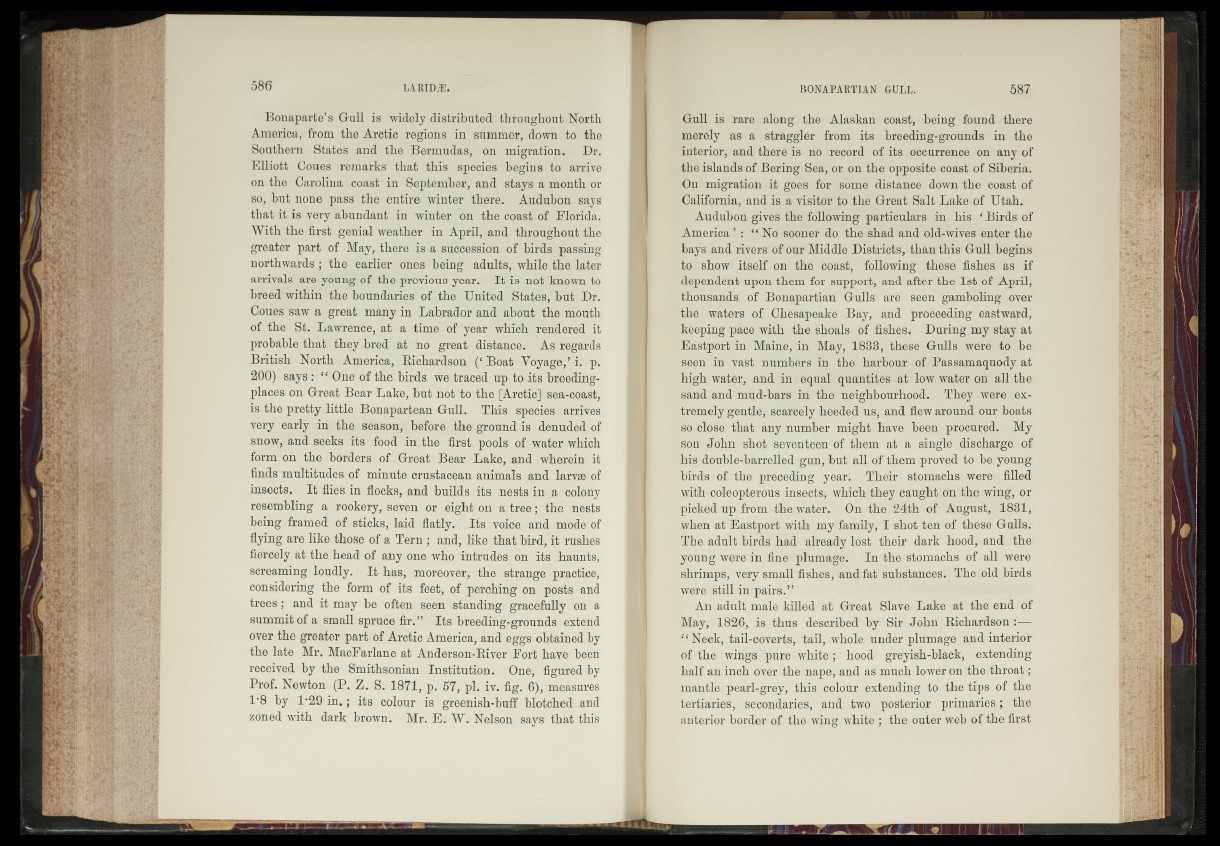
Bonaparte’s Gull is widely distributed throughout North
America, from the Arctic regions in summer, down to the
Southern States and the Bermudas, on migration. • Dr.
Elliott Cones remarks that this species begins to arrive
on the Carolina coast in September, and stays a month or
so, hut none pass the entire winter there. A.udubon says
that it is very abundant in winter on the coast of Florida.
With the first genial weather in April,rand throughout the
greater part of May, there is a succession of birds passing
northwards; the earlier ones being adults, while the later
arrivals are young of the previous year. It is: not known to
breed within the boundaries of the United States, hut Dr.
Coues saw a great many in- Labrador and about the mouth
of the St.- Lawrence, at a time of year which rendered it
probable that'-they bred at no great distance.' As regards
British North America, Bichardson (‘ Boat Voyage,’ i. p.
200) says : “ One of the birds we traced up to its breeding-
places on Great Bear Lake, but not to the [Arctic] sea-coast,
is the pretty little Bonapartean Qulh This species arrives
very early in the season, before the ground is -denuded of
snow, and seeks its food in the first pools of water, which
form o n ‘the borders of Great Bear Lake, and wherein it
finds multitudes of minute crustacean animals and larvae of
insects. It flies in flocks, and builds its nests in a colony
resembling a rookery, seven or eight, on a t r e e th e nests
being framed of sticks, laid flatly.* Its, vrpfe and mode öf
flying are like those of a Tern '; and, like that bird, it-rushes
fiercely at the head óf any one who intrudes on its haunts,
screaming loudly. It has, moreover,. the strange practice,
considering the form of its feet, of perching on posts and
trees; and it may be often, seen standing gracefully on a
summit of a small spruce fir.” Its breeding-grounds extend
over the greater part of Arctic America, and eggs-obtained by
the late Mr. MacFarlane at Anderson-Bi vér Fort have been
received by >the’ Smithsonian Institution. One, figured by
Prof. Newton Z. Swl871, p. 57, pi. iv. fig. 6),,rmeasures
1‘8 by 1-29 in .; its colour-is greenish-buff blotched- and
zoned with dark brown. Mr. E. W. Nelson say§ that this
Gull is rare along the Alaskan coast, being found there
merely as a straggler from its breeding-grounds in the
interior, and there is no record of its occurrence on any of
the islands of Bering Sea, or on the opposite coast of Siberia.
On migration it goes for some distance dowrrthe coast of
California, and is a visitorto tbg-Great Salt Lake of Utah.
: Audubon gives the following particulars in his | Birds of
America’ : “ No sooner do the shad and old-wives enter the
bays and rivers of our Middle Districts; than this Gull begins
to show itbelf on the coast, following these fishes as if
dependent upon them for support, and after the 1st of April,
thousands of Bonapartian Gulls are seen gamboling over
the waters of Chesapeake Bay, and proceeding eastward,
keeping pace with the shoals of fishes. During my stay at
Eastport in Maine,.in May, 1888, these Gulls were to be
seen in vast numbers in the. harbour of Passamaquody at
high water, and in *-equal quantites^t low water on all the
sand and mud-bars in the neighbourhood. They were extremely
gentle; scarcely bedded ns, and flew around our boats
so close that any number might have been procured. My
Son John- shot seventeen-of them at a single discharge of
his*double-barrelled gun, but all of them proved to be young
birds of the preceding, 'yearh- Their stomachs were filled
with coleopterous insects; which-they caught’on the wing, or
picked-up from the-^ater. On-the'24th of August, 18.31,
when at-Eastport with my family, I shot ten of these Gulls.
Ififse aduMlbirds had already lost their dark hood, -and the
young; wereln fine plumage. In the stomachs of all, were
shrimps, very small-fishes, and fat substances. The-old birds
were stilMupaifs.’’''
An adult male drilled -at Great Slave Lake at the end of
May, ■ 1826, is thus- described -by Sir John Bichardson
;$e'Neck, tail-coverts, tail, whole underiplumage and interior
of 4be wings "pure white*; hood greyish-black, extending,
half an inch over the nape, and as much lower on the throat#*
mantle pearl-grey; * this colour extending te. the tips of the
Sertiaries, secondaries, and -two* posterior primaries;; the
anterior" borde%of* the wing whiter;|bhe. outer .web of the first